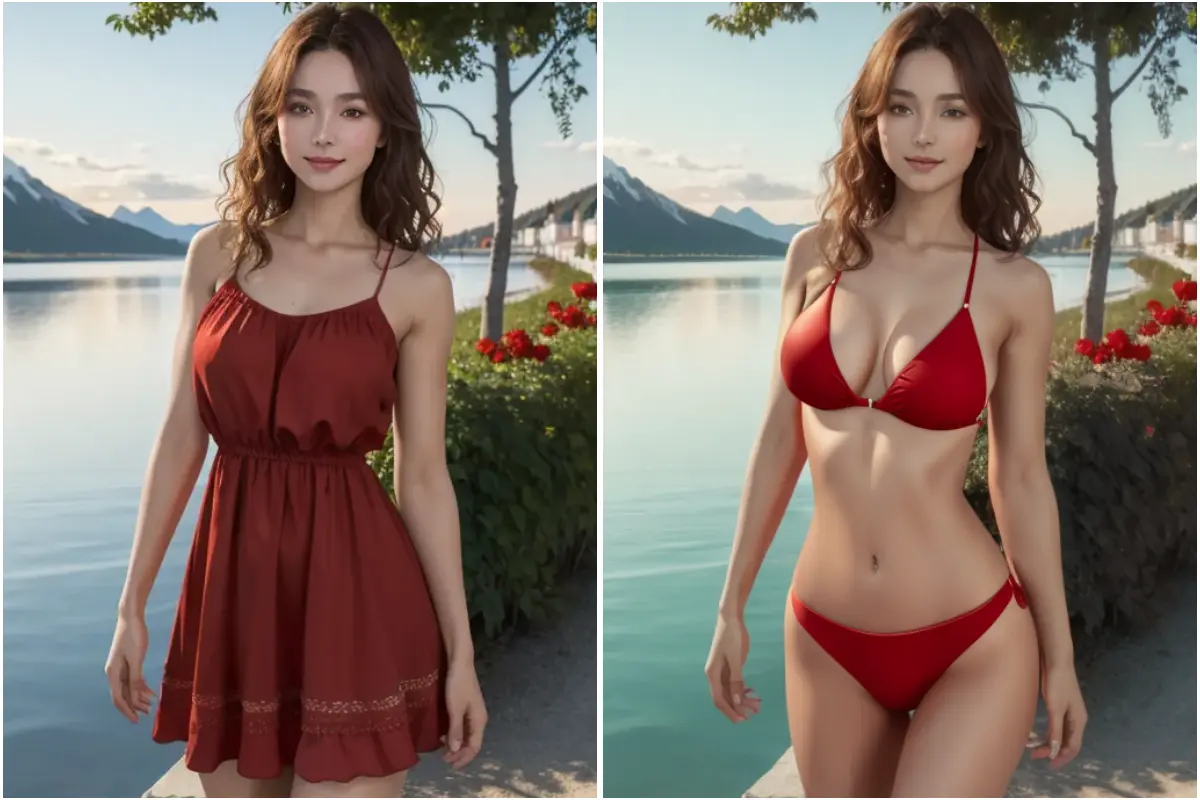Free AI Clothes Remover: Remove Clothes Instantly & Easily!
In an age dominated by digital imagery, where visuals reign supreme, does the ability to effortlessly manipulate photographs represent a groundbreaking shift in creative potential, or a dangerous descent into the realm of fabricated realities? The rise of AI-powered tools capable of removing clothing from images, offering features previously confined to skilled professionals, demands careful consideration of both its potential and its pitfalls.
The allure is undeniable. A landscape of possibilities opens up, where digital artists can seamlessly integrate virtual garments onto models, designers can visualize their creations on diverse body types without the constraints of physical prototypes, and fashion enthusiasts can experiment with different styles, all from the comfort of their screens. The process itself is streamlined, promising ease of use for even the most novice user. Platforms boast intuitive interfaces, often requiring nothing more than a simple image upload, followed by the AI's automated processing. The promise of "stunning, realistic editing results" is dangled before the user, fueled by advanced algorithms meticulously trained to identify clothing layers and generate results that appear natural.
But beyond the immediate appeal, the implications of this technology are far-reaching. The accessibility and efficiency of these tools are reshaping how we interact with images, raising critical questions about authenticity, privacy, and the ethical boundaries of digital manipulation. The claim of "100% free AI clothes remover" and the prevalence of websites offering this service are indications of a growing trend. This accessibility democratizes the ability to alter images with potentially serious consequences. The capacity to create "deepnude" images, where clothing is removed to generate an image of nakedness, is of particular concern, especially when considering the potential for non-consensual creation and distribution.
- Lacy Kim Fact Vs Fiction The Ai Controversy Explained
- Buscar Kid Mom Cctv Viral Story Ethical Concerns
Let's delve deeper into the capabilities and implications. A key feature of many of these platforms is the offer of free trials. New users can test the platform's core features without any upfront cost, allowing them to explore the capabilities and assess the quality of the output. Often, a limited number of free trials are offered daily, perhaps ten attempts per day, to encourage further engagement and potentially, conversion to paid subscriptions or premium features. The underlying technology is built on sophisticated AI models. The system meticulously analyzes every element within an image, paying close attention to details to maintain natural features. This attention to detail, including the realistic drape of skin and form, is crucial in creating convincing and authentic results. This is why the tools emphasize their "advanced technology," which carefully processes every element, removing clothing while maintaining natural detail.
One of the most common selling points of these tools is the ease of use. The process of removing clothing is intended to be fully automated. The user needs only to upload their chosen image, and the AI handles the rest. The system identifies the clothing layers within a photo, applying its algorithms to generate a seamless, and in the best-case scenarios, realistic, output. This ease of use, however, should not be taken for granted. It is the simplicity which makes the technology so potentially disruptive. The tools are designed to give the user an effortless way to remove and replace clothing in images with just a few quick clicks. The claim of achieving "stunning, realistic editing results" is a compelling one, drawing in users who may not possess advanced photo editing skills.
The underlying technology is not as simple as it might seem. The creation of believable results demands an understanding of human anatomy, the perspective of the body in space, and the nuances of lighting. Retouchers with professional skills take into account elements of lighting, including shadow and light sources, to create a seamless outcome. To address the need for more advanced photo editing functionalities, many platforms also provide basic editing tools such as background removal, image format conversion (jpg, png, gif, webp), and image compression. Platforms also provide ai clothes changer to help users virtually try on different clothing. The main features of this ai technology is that users can visualize how clothing would look in a realistic setting.
- Texas Mom In Tears Over Sons Tribute To Late Dad Heartwarming
- Neil Diamond Health Update Latest News Parkinsons Journey 2024
The potential uses are varied. Designers can utilize these tools to visualize how garments fit and drape on different body types. Artists can modify images for their artistic projects, enhancing them and ensuring a realistic finish. Fashion-forward individuals can transform portraits by swapping outfits to suit designs or creative projects. Platforms are becoming increasingly popular because they allow users to easily and quickly remove clothes from photos online. There are many free undress AI tools to remove clothes with AI, like Anierasers AI clothes remover, which is an advanced online tool designed to help users remove clothing from images. Tools like Unclothy are designed to undress photos.
The advent of AI clothes removers necessitates a reevaluation of how we interpret images and the trust we place in them. While the applications for designers, artists, and those interested in personal experimentation are real, it is the potential for misuse that must take precedence. The ability to create "deepnude" images is particularly alarming, especially when we consider the likelihood of non-consensual creation and dissemination. When these images fall into the wrong hands, the damage can be immeasurable. The focus needs to be not just on the innovation of the technology but the ethical considerations of how it is used.
The question of ethics and the potential for misuse also must be kept in mind when speaking about image manipulation. It is important to note that the ethical guidelines will need to be in place to avoid the proliferation of non-consensual images. The industry needs to be transparent and make sure that image-altering technology is used to assist in artistic endeavors but also with a strong emphasis on preventing the creation of harmful content.
As technology continues to advance, the lines between reality and digitally created fiction become increasingly blurred. The user of these tools must be aware of these complexities and the responsibilities that come with them. Whether the advancements will lead to a greater degree of creative potential, or a greater risk for misinformation, depends on the actions of creators, consumers, and the policies that govern their use.
The future of the AI clothes remover is now intertwined with the ethical landscape, requiring careful consideration of how these tools shape our perceptions of reality. With education, strong ethical guidelines, and a commitment to responsible use, we can harness this technological evolution and harness its power for good, while mitigating the risks of misuse and safeguarding the principles of consent and privacy.
Table: Key Features of AI Clothes Removers
| Feature | Description |
|---|---|
| Free Trials | Many platforms offer a limited number of free trials, usually around 10 per day, for new users to test the capabilities. |
| Automated Processing | The process is largely automated, requiring only an image upload; the AI handles the removal and replacement of clothing. |
| Realistic Results | Advanced AI models are used to maintain natural details and generate outputs that appear realistic. |
| Ease of Use | Platforms are designed to be user-friendly, requiring minimal technical expertise. |
| Additional Tools | Some platforms offer other functions such as background removal, image format conversion, and compression. |
| AI Clothes Changer | The AI clothes changer feature lets users try on various clothing styles. |
Key Considerations:
| Consideration | Importance |
|---|---|
| Ethics | The ethical implications of generating non-consensual images must be considered. |
| Privacy | Images that are created could have damaging repercussions, and privacy is a major concern. |
| Authenticity | The ease of manipulation raises questions about the trustworthiness of digital content. |
| Misuse | There is an increased risk of the malicious use of these tools, including non-consensual image creation. |
Website Resources for Further Research:
Deepfake - Wikipedia
It is important to acknowledge the ethical and practical considerations that come with the growing use of such technology. While it might open new doors in the creative and professional industries, we must also take into account the potential for abuse. This is an evolving discussion, and as such, it necessitates continuous adaptation and education to make sure that we can mitigate any harmful consequences while making the most of the technological advances.
- Explore New Comics On Honeytoon Read Now Discover
- Discover Hdhub4u Your Guide To Bollywood More 2024

AI Clothes Remover Website Free Open AI Master
![Try AI Clothes Remover Tool [Free] Online 100 Real Cpen AI](https://cpen.ai/wp-content/uploads/2024/07/1000011157.webp)
Try AI Clothes Remover Tool [Free] Online 100 Real Cpen AI

Free AI Clothes Remover Online